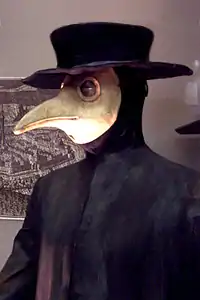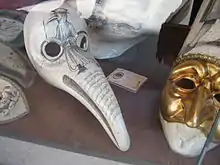Plague doctor costume
The clothing worn by plague doctors was intended to protect them from airborne diseases. The costume, used in France and Italy in the 17th century, consisted of an ankle-length overcoat and a bird-like beak mask, often filled with sweet or strong-smelling substances (commonly lavender), along with gloves, boots, a wide-brimmed hat, and an outer over-clothing garment.[2]
Description

The mask had glass openings for the eyes and a curved beak shaped like a bird's beak with straps that held the beak in front of the doctor's nose.[3] The mask had two small nose holes and was a type of respirator which contained aromatic items.[4] The beak could hold dried flowers (including roses and carnations), herbs (including lavender and peppermint), spices, camphor, or a vinegar sponge.[5][6] The purpose of the mask was to keep away bad smells, known as miasma, which were thought to be the principal cause of the disease. Doctors believed the herbs would counter the "evil" smells of the plague and prevent them from becoming infected.[3]
The beak doctor costume worn by plague doctors had a wide-brimmed leather hat to indicate their profession.[2][7] They used wooden canes in order to point out areas needing attention and to examine patients without touching them.[8] The canes were also used to keep people away,[9] to remove clothing from plague victims without having to touch them, and to take a patient's pulse.[2][10]
History
Medical historians have attributed the invention of the "beak doctor" costume to the French doctor Charles de Lorme, who adopted in 1619 the idea of a full head-to-toe protective garment,[11] modeled after a soldier's canvas gown which went from the neck to the ankle.[11][12][13] The over-clothing garment, as well as leggings, gloves, boots, and a hat, were made of waxed leather.[14] The garment was impregnated with similar fragrant items as the beak mask.[15]
Lorme wrote that the mask had a "nose half a foot long, shaped like a beak, filled with perfume with only two holes, one on each side near the nostrils, but that can suffice to breathe and to carry along with the air one breathes the impression of the drugs enclosed further along in the beak".[16]
The Genevese physician Jean-Jacques Manget, in his 1721 work Treatise on the Plague written just after the Great Plague of Marseille, describes the costume worn by plague doctors at Nijmegen in 1636–1637. The costume forms the frontispiece of Manget's 1721 work.[17] The plague doctors of Nijmegen also wore beaked masks. Their robes, leggings, hats, and gloves were made of Morocco leather.[18]
This costume was also worn by plague doctors during the Plague of 1656, which killed 145,000 people in Rome and 300,000 in Naples.[19] The costume terrified people because it was a sign of imminent death. Plague doctors wore these protective costumes in accordance with their agreements when they attended their plague patients.
Carnival

The costume is also associated with a commedia dell'arte character called Il Medico della Peste (lit: The Plague Doctor), who wears a distinctive plague doctor's mask.[20] The Venetian mask was normally white, consisting of a hollow beak and round eye-holes covered with clear glass, and is one of the distinctive masks worn during the Carnival of Venice.[21]
See also
- Gas mask – Protection from inhaling airborne pollutants and toxic gases
- Hazmat suit – Protective suit against chemical, bacteriological, and nuclear risks
- NBC suit – Type of military personal protective equipment
- N95 mask
- PPE gown
References
Footnotes
- Füssli's image is reproduced and discussed in Robert Fletcher, A tragedy of the Great Plague of Milan in 1630 (Baltimore: The Lord Baltimore Press, 1898), p. 16–17.
-
- Pommerville (Body Systems), p. 15
- Bauer, p. 145
- Byfield, p. 26
- Glaser, pp. 33-34
- Ellis, p. 202
-
- Time-Life Books, pp. 140, 158
- Dolan, p. 139
- Ellis, p. 202
- Paton
- Martin, p. 121
- Sherman, p. 162
- Turner, p. 180
- Mentzel, p. 86
- Glaser, p. 36
- Hall, p. 67
- Infectious Diseases Society of America, Volume 11, p. 819
- Grolier, p. 700
- O'Donnell, p. 135
- Stuart, p. 15
- Center for Advanced Study in Theatre Arts, p. 83
- Doktor Schnabel von Rom, engraving by Paul Fürst (after J Columbina), Rome 1656.
- American Medical Association - JAMA.: The Journal of the American Medical Association, Volume 34, p. 639 (unsubstantiated inference; requires different citation)
- Pommerville, p. 9
- Boeckl, p. 15
- Carmichael, A.G. (2009), "Plague, Historical", in Schaechter, Moselio (ed.), Encyclopedia of Microbiology (3rd ed.), Elsevier, pp. 58–72, doi:10.1016/B978-012373944-5.00311-4, ISBN 9780123739445
- Iqbal Akhtar Khan (May 2004). "Plague: the dreadful visitation occupying the human mind for centuries". Transactions of the Royal Society of Tropical Medicine and Hygiene. 98 (5): 270–277. doi:10.1016/S0035-9203(03)00059-2. PMID 15109549.
Charles Delorme (1584—1678), personal physician to King Louis XIII, was credited with introducing special protective clothing for plague doctors during the epidemic in Marseilles. It consisted of a beak-like mask supplied with aromatic substance, presumed to act as filter against the odour emanating from the patients, and a loose gown covering the normal clothing. On occasions, a drifting fragrance such as camphor was used.
-
- Pommerville (Body Systems), p. 15
- Hirts, p. 66
- Reynolds, p. 23
- Time-Life Books, p. 158 Beak Doctor: during the Black Plague, a medical man who wore a bird mask to protect himself against infection. Black plague definition: In 14th-century Europe, the victims of the "black plague" had bleeding below the skin (subcutaneous hemorrhage) which made darkened ("blackened") their bodies. Black plague can lead to "black death" characterized by gangrene of the fingers, toes, and nose. Black plague is caused by a bacterium (Yersinia pestis) which is transmitted to humans from infected rats by the oriental rat flea.. medterm.com
- Vidal, Pierre; Tibayrenc, Myrtille; Gonzalez, Jean-Paul (2007). "Chapter 40: Infectious disease and arts". In Tibayrenc, Michel (ed.). Encyclopedia of Infectious Diseases: Modern Methodologies. John Wiley & Sons. p. 680. ISBN 9780470114193.
- Manget, p. 3
- Timbs, p. 360
- The Plague Doctor
- Killinger, p. 95
- Carnevale
Works cited
- Bauer, S. Wise, The Story of the World Activity Book Two: The Middle Ages : From the Fall of Rome to the Rise of the Renaissance, Peace Hill Press, 2003, ISBN 0-9714129-4-4
- Boeckl, Christine M., Images of plague and pestilence: iconography and iconology, Truman State Univ Press, 2000, ISBN 0-943549-85-X
- Byfield, Ted, Renaissance: God in Man, A.D. 1300 to 1500: But Amid Its Splendors, Night Falls on Medieval Christianity, Christian History Project, 2010, ISBN 0-9689873-8-9
- Byrne, Joseph Patrick, Encyclopedia of Pestilence, Pandemics, and Plagues, ABC-CLIO, 2008, ISBN 0-313-34102-8
- Carmichael, Ann G., "SARS and Plagues Past", in SARS in Context: Memory, history, policy, ed. by Jacalyn Duffin and Arthur Sweetman McGill-Queen's University Press, 2006, ISBN 0-7735-3194-7
- Center for Advanced Study in Theatre Arts, Western European stages, Volume 14, CASTA, 2002,
- Dolan, Josephine, Goodnow's History of Nursing, W. B. Saunders 1963 (Philadelphia and London), LCCN 16--25236, OCLC 2882574
- Ellis, Oliver Coligny de Champfleur, A History of Fire and Flame, London: Simkin, Marshall, 1932; repr. Kessinger, 2004, ISBN 1-4179-7583-0
- Goodnow, Minnie, Goodnow's history of nursing, W.B. Saunders Co., 1968, OCLC Number: 7085173
- Glaser, Gabrielle, The Nose: A Profile of Sex, Beauty, and Survival, Simon & Schuster, 2003, ISBN 0-671-03864-8
- Grolier Incorporated, The Encyclopedia Americana, Volume 8; Volume 24, Grolier Incorporated, 1998, ISBN 0-7172-0130-9
- Hall, Manly Palmer, Horizon, Philosophical Research Society, Inc., 1949
- Hirst, Leonard Fabian, The conquest of plague: a study of the evolution of epidemiology, Clarendon Press, 1953,
- Infectious Diseases Society of America, Reviews of Infectious Diseases, Volume 11, University of Chicago Press, 1989
- Kenda, Barbara, Aeolian winds and the spirit in Renaissance architecture: Academia Eolia revisited, Taylor & Francis, 2006, ISBN 0-415-39804-5
- Killinger, Charles L., Culture and customs of Italy, Greenwood Publishing Group, 2005, ISBN 0-313-32489-1
- Nohl, Johannes, The Black Death: A Chronicle of the Plague, J. & J. Harper Edition 1969, LCCN 79--81867, OCLC 34505
- Manget, Jean-Jacques, Traité de la peste recueilli des meilleurs auteurs anciens et modernes, Geneva, 1721, online as PDF, 28Mb download
- Martin, Sean, The Black Death, Book Sales, 2009, ISBN 0-7858-2289-5
- Mentzel, Peter, A traveller's history of Venice, Interlink Books, 2006, ISBN 1-56656-611-8
- O'Donnell, Terence, History of life insurance in its formative years, American Conservation Company, 1936
- Paton, Alex, "Cover image", QJM: An International Journal of Medicine, 100.4, 4 April 2007. (A commentary on the issue's cover photograph of The Posy Tree, Mapperton, Dorset.)
- Pommerville, Jeffrey, Alcamo's Fundamentals of Microbiology: Body Systems, Jones & Bartlett Learning, 2009, ISBN 0-7637-6259-8
- Pommerville, Jeffrey, Alcamo's Fundamentals of Microbiology, Jones & Bartlett Learning, 2010, ISBN 0-7637-6258-X
- Reynolds, Richard C., On doctor[i]ng: stories, poems, essays, Simon & Schuster, 2001, ISBN 0-7432-0153-1
- Sandler, Merton, Wine: a scientific exploration, CRC Press, 2003, ISBN 0-415-24734-9
- Sherman, Irwin W., The power of plagues, Wiley-Blackwell, 2006, ISBN 1-55581-356-9
- Stuart, David C., Dangerous garden: the quest for plants to change our lives, frances lincoln ltd, 2004, ISBN 0-7112-2265-7
- Timbs, John, The Mirror of literature, amusement, and instruction, Volume 37, J. Limbird, 1841
- Time-Life Books, What life was like in the age of chivalry: medieval Europe, AD 800-1500, 1997
- Turner, Jack, Spice: The History of a Temptation, Random House, 2005, ISBN 0-375-70705-0
- Walker, Kenneth, The story of medicine, Oxford University Press, 1955
External links
![]() Media related to Plague doctors at Wikimedia Commons
Media related to Plague doctors at Wikimedia Commons
.png.webp)